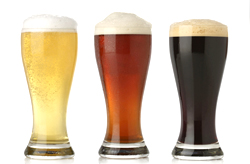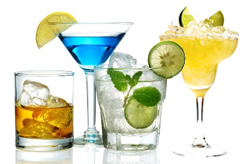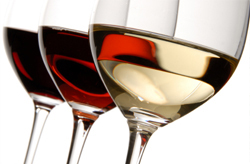BEER
SPIRIT
WINE
- Craft Beer
Craft brewers are defined by the Brewer's Association as those that are small (produces 6 million barrels or fewer per year), independent (less than 25% of the brewery is itself owned or controlled by an alcoholic beverage industry member who themselves is not a craft brewer), and traditional (having an all-malt flagship or has at least 50% of its volume from all malt beers or in beers that use adjunts to enhance the flavor of the beer). - Dark Beer
Dark ale is a British type beer, combining hops, yeast and a blend of malts. It's a medium chestnut brown colour, with a delicate fruity smell and robust, malty character. - Light Beer
Light beer has fewer calories and/or lower alcohol content. It is extremely light in colour and mild in flavour.
SPIRIT
- Brandy & Cognac
Brandy is a spirit produced by distilling wine. Brandy generally contains 35–60% alcohol by volume. Some brandies are aged in wooden casks, some are coloured with caramel colouring to imitate the effect of aging, and some brandies are produced using a combination of both aging and colouring.
Cognac named after the town of Cognac in France, is a variety of brandy. It is produced in the wine-growing region region/town of France.
Cognac must be made from specified grapes, of which Ugni blanc, is the one most widely used. The brandy must be twice distilled in copper pot stills and aged at least two years in French oak barrels from Limousin or Tronçais. Most Cognac is aged considerably longer than the minimum legal requirement.
One of the main differences of Brandy to Cognac is the aging in wood. Where Cognac requires it, Brandy does not. Along these lines some Brandies contain added coloring to simulate the wood aging. But the region of grape growth can not be ignored either. Cognac is governed by strict laws in France, Brandy is free to be more loose in its methods the world over.
- Mezcal & Tequila
Mezcal, or mescal, is a distilled alcoholic beverage made from the maguey plant (a form of agave, Agave americana) native to Mexico. The maguey grows in many parts of Mexico, though most mezcal is made in Oaxaca.
Tequila is a regional specific name for a distilled beverage made from the blue agave plant, primarily in the area surrounding the city of Tequila, the north western Mexican state of Jalisco.
Tequila and mezcal are produced in different states of Mexico and the production process is different. Tequila can only be made, by law, with one variety of agave: the Blue Agave. Mezcal can be made with upwards of 30 varieties of agave, though most are made with the Agave Espadin.
- Rum & Vodka
Rum is a distilled alcoholic beverage made from sugarcane byproducts, such as molasses, or directly from sugarcane juice, by a process of fermentation and distillation. The distillate, a clear liquid, is then usually aged in oak barrels.
Vodka is a distilled beverage composed primarily of water and ethanol, sometimes with traces of impurities and flavorings. Traditionally, vodka is made by the distillation of fermented grains or potatoes, though some modern brands use other substances, such as fruits or sugar.
- Scotch & Whisky
Scotch whisky, often simply called Scotch, is malt whisky or grain whisky made in Scotland. Scotch whisky must be made in a manner specified by law. All Scotch whisky was originally made from malted barley, however commercial distilleries began introducing whisky made from wheat and rye in the late 18th century. All Scotch whisky must be aged in oak barrels for at least three years.
Whisky or whiskey is a type of distilled alcoholic beverage made from fermented grain mash. Various grains (which may be malted) are used for different varieties, including barley, corn, rye, and wheat. Whisky is typically aged in wooden casks, generally made of charred white oak.
The main difference between scotch and whisky is geographic, but also ingredients and spellings.
WINE
- Entry-Level Wine
The wine from a producer's portfolio that is the lowest cost for purchase and offers the most basic quality.
- High-Level (Premium) Wine
Higher quality classification of wine above every day drinking table wines. While premium wines maybe very expensive there is no set price point that distinguishes when a wine becomes a "premium wine." Premium wines generally have more aging potential than every day quaffing wines.
|
Sri Lanka has a strong drinking culture – beer was introduced by foreign captives during the Kandyan period, and the islanders have never looked back. The island’s two staple forms of alcohol are lager and arrack. Lager is usually sold in large (625ml) bottles; draught lager is rare.
|
About 65 percent of the total alcohol market in Sri Lanka is estimated to be illicit, with 30 percent consisting of legal hard liquor and just five percent beer. The sales of hard liquor had increased "marginally" owing to the upturn in the economy and increased incomes among consumers following the ceasefire.
|
Wine business in Sri Lanka is still in its infancy due to supply disruption, religious and cultural issues. Wine is very expensive in Sri Lanka compare to other local drinks due to the governments tax but available in the most of big hotels.
|
SOURCE: craftbeercellar.com, thebeerstore.ca/beer-101/beer-types, winefugitive.com/glossary-of-wine-terms/, wikipedia.org, roughguides.com



